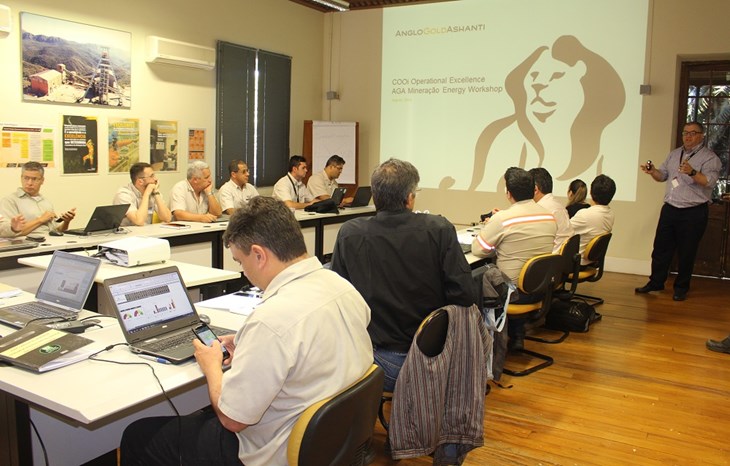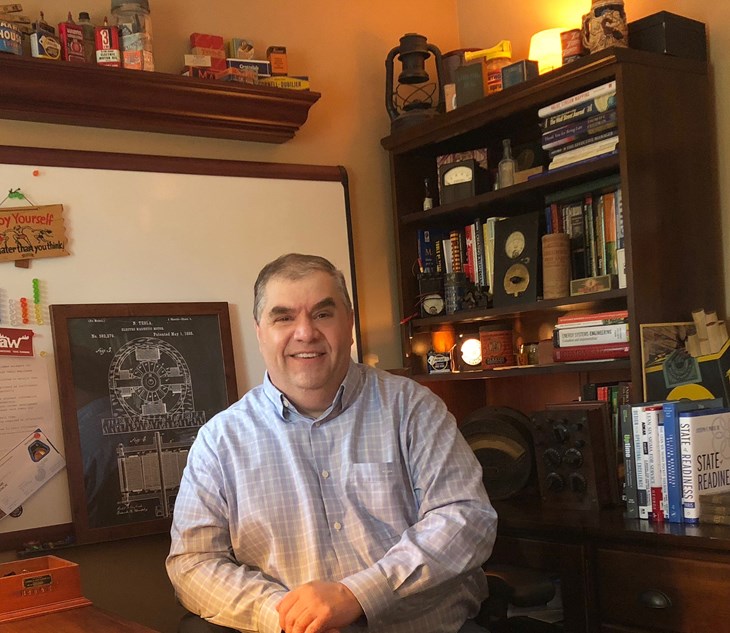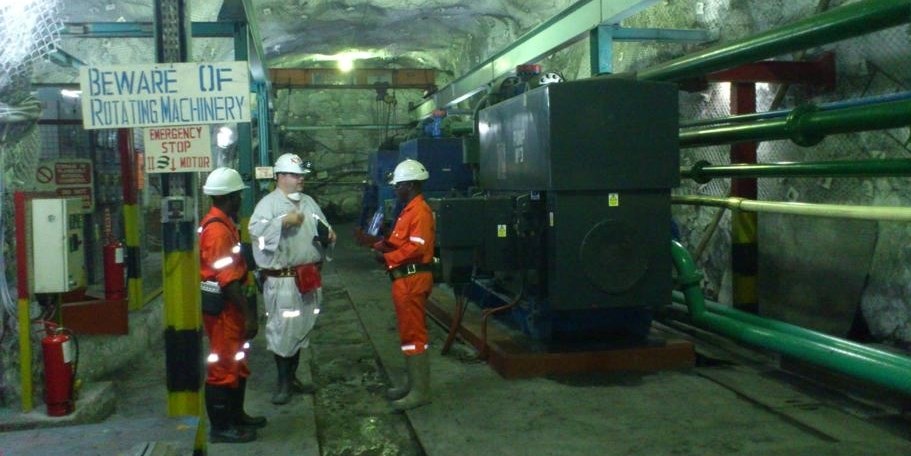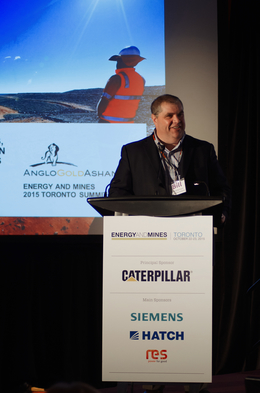Bill Allemon cannot remember a time when he was not interested in all electrical things. As a child, he enjoyed taking things apart and putting them back together—but more electrical items than mechanical ones. As an adult, he surrounds himself with a unique collection of antique electrical equipment.
“My home office looks like Edison’s library,” Allemon said. “But I do not try to take these things apart. The more digital my life becomes the more I like things to be more analog.”
Allemon began his career as an electrical draftsman for an electrical contractor, while simultaneously pursuing his Bachelor of Science in electrical engineering. After graduation, he worked for an architectural engineering firm as an electrical designer for a few years before beginning a 21-year career at Ford Motor Company. While at Ford, he progressed through various roles from Project Engineer to Corporate Energy Manager before leaving in 2010 for an opportunity to work with a global consulting firm.
“After a few years in consulting, I ran back to the comforting bosom of heavy industry,” he said. “While at AngloGold Ashanti, I lead the company’s energy management and electrical asset management efforts across its International Division. This included 13 mines outside of its South African operations, which encompassed mining sites across the Americas, Africa, and Australia.”
With regard to valves and pumps, Allemon’s career has centered mostly around installation projects and ensuring that operations are properly maintained and operating efficiently. This includes onsite energy assessments, maintenance reviews and training of both technical and management best practices to ensure that assets are being effectively used.
He recently started his own consulting firm, Conduit Process Excellence, LLC. In this capacity, he provides the same skills and services that he successfully delivered during his 31 years in the corporate world, but now offering them to a broad range of clients. Services include most aspects of energy management, sustainability program management and implementation, electrical asset and risk management, as well as coaching and mentoring of professionals across the energy field.
“I was getting requests for assistance because I know so many other corporate energy managers,” he explained. “This was a need in the market that kind of came to me in a sense, so I decided to make it formal.”
Allemon has discovered that there is no shortage of technical experts. “If a client is looking for someone to fix a single physical issue with a pumping system, those professionals are relatively abundant—whether the client wants someone with decades of field experience, a licensed professional engineer or a Ph.D. to conduct a theoretical study,” he said. “The problem with these approaches is that they are singular events and not addressing the systemic issues that are allowing these failures to occur in the first place. They are basically putting out fires, instead of finding and locking up the arsonist.”
To illustrate this, Allemon cited some statistics from a webinar he recently attended hosted by The Institute of Asset Management where Terrence O’Hanlon from ReliabilityWeb.com talked about a study they completed with other researchers called the Asset Management Best Practices Study. In their research, they found the top challenge for asset management programs is 25% lack of funding, 18% failure to prioritize, 12% lack of program sponsorship, 40% culture, with the remaining 5% being other categories.
“This showcases that the top driver of an asset management program is the culture of the organization,” he said. “This is paramount. As Terrance mentioned in the call, culture drives performance and leadership drives culture. No volume of plans, frameworks, best practices, or other tools will ensure the program is successful if company leadership is not behind the program. I know of two global mining organizations that completely dismantled their asset management departments simply because someone in a corner office was not properly educated on its effectiveness and benefit to the bottom line. While looking for overhead cost reduction actions, they simply reviewed the fully-loaded salary and benefits of the team and estimated how much can be saved by eliminating the operation. Comically, after a few years and management reorganizations, these companies experience critical failures in their engineering systems that affect production and are then able to show value by rebuilding the reliability team. And the whole process starts over again.”
There are two root causes for this phenomenon, Allemon said. One is the lack of communication to senior leadership and the other is the failure of integrating these programs into their normal business processes.
“The same is true in the energy management space,” he said. “It is common for engineers and maintenance professionals to focus on the technical aspects of performance or the newest technology, but lack the soft skills to communicate the value of their work outside of the engineering department. This is the space that I am focused on—helping engineering teams and organizations build, lead and communicate an effective energy management program. I also help senior leadership build, fund and support energy and maintenance teams, so they can focus on implementation and not building presentations.
“I also help engineers and maintenance managers incorporate various Operational Excellence tools into their work. Many times, they are left out because of the false impression that those tools are only related to production operations. But if you look at energy waste or electrical risk as a defect, you can then apply the same Operational Excellence tools as the production teams.”
Putting together an effective energy management program takes some experience. “There are also clients that had someone come in and build a program for them, but they need help implementing it. So many engineers are very technical, but they do not have the soft skills. As far as technologies and analysis there are lots of opportunities. As far as education and promotion and culture change—that is where there is a big need in the market. This is where there is a gap and where I am trying to focus.”
For example, while at AngloGold Ashanti, Allemon learned that, like a lot of companies, they had energy managers in the past and tried to manage energy using singular projects with individual efforts. “But they did not implement a systematic process,” he said. “During my tenure, this is what I did. I developed an energy management system that included training, audits, projects and found things to do to reduce cost and consumption. Throughout the 5 years I was there, my team and I developed documents and tools and implemented them globally. Now they have a systematic process they can reference and continue forward. As I visited the mines, I noticed there was not a lack of talent among the engineers, but they were implementing individual actions. They had reached a plateau and needed a mentor or a coach inside to help them get to the next level.”
Allemon has worked at the corporate level in both the automotive manufacturing and mining industries and all facility types including field operations, office buildings, laboratories, data centers and central power generation stations. In a consulting role, he has worked in the pharmaceutical, healthcare, higher education, manufacturing, consumer goods, Federal and other sectors. His work has focused on performing sustainability, energy or asset assessments to help reduce cost, carbon footprint, implement green building certifications or mitigate electrical issues.

Problem Solving
The biggest problem with regard to pumps and valves that Allemon has experienced across all industries is the fascination with new technologies, but not the effective use of them, he said.
“I think the term Bright Shiny Object Syndrome fits well here and it affects all levels of an organization. We engineers like to try new products, as opposed to improving management processes. Managers like new technologies, thinking that it will give them a chance to replace an aging asset with better performance. Finance managers prefer to fund capital projects to update physical assets, as opposed to increasing maintenance budgets. And senior leaders are always looking for some new out-of-the-box idea that is ‘disruptive’ and promises to magically provide a higher level of performance. But new assets are frequently poorly managed and fail to deliver their full potential.”
For example, Allemon said he has seen many data collection and SCADA systems installed only to have a small percentage of their capability actually used. “We are seeing this problem right now with the whole Industry 4.0 movement and promotion of Internet of Things (IoT) in the industrial sector. Collecting more data is only beneficial if there is a means to properly analyze that data and put the results to work. Again, those analytical systems are out there, but installing them and not properly using them helps no one. Imagine if that data was physical tools and sheets of reports. We would be quickly buried.”

Advice for Young End Users
Allemon admits that while growing up near Detroit, Michigan, he was not a great student. A counselor advised him to become an electrician or technician rather than pursuing engineering.
“I was really down and thought perhaps I should not pursue what I really wanted to do,” he said. “But then I realized it was just one man’s opinion. I thought it would be better to try and fail than to have never tried. I went to college and did not break any academic records or make the Dean’s List, but I got through engineering school and brick-by-brick pursued my interests. Once in the workforce, it was this personal grit that helped me succeed and develop a pragmatic approach, while the outstanding students were frequently mired in theory.”
Because of this, as well as his more than three decades of experience, Allemon has advice for young end users.
“Your career will start on the technical aspects of engineering design and operations, and it is important to develop this foundation, regardless of whether you wish to build your career as a technical specialist or move into a management position,” he advised. “Experience and learn as much as possible because these experiences will build your professional foundation and stay with you during your entire career. Do not be afraid to make mistakes, since we learn more from them than successes. And be sure to learn from the mistakes of others. All experiences, good and bad, provide benefits. You cannot buy experience and no one can take it away from you once you have it.
“My other advice is to start early and build your professional network, both with technical experts and career mentors. A solid professional network is the new career currency. I continue to build mine, but also stay in touch with a select number of professionals that I met decades ago because they have integrity, knowledge, and experience.”
Allemon stresses that while it is important to be technically adept, success is determined by much more than just that. “When it comes to energy and equipment, there is the hard side of the pumps and valves—the technical side,” he said. “The other side is managing it, and operating it correctly. I see so many systems and hardware that get installed, but then are not used to their capability. My effort is more the training of soft skills, helping people address all aspects of energy management and asset management—and not just buying the newest bright, shiny object.”






